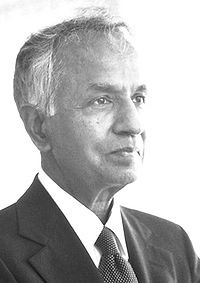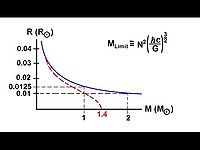Subrahmanyan Chandrasekhar
Claimed by Ethan DCunha edcunha3
Subrahmanyan Chandrasekhar was an Indian American astrophysicist born in Lahore, Punjab. Chandrasekhar was awarded, along with William A. Fowler, the 1983 Nobel Prize for Physics, with Chandrasekhar cited for his mathematical theory of the physical processes of importance to the structure and evolution of the stars. This work led to the currently accepted theory on the later evolutionary stages of massive stars, including black holes.
Subrahmanyan Chandrasekhar was one of the foremost astrophysicists of the twentieth century. He was one of the first scientists to couple the study of physics with the study of astronomy. Chandra proved that there was an upper limit to the mass of a white dwarf. This limit, known as the Chandra limit, showed that stars more massive than the Sun would explode or form black holes as they died. Chandra also developed theories on star atmospheres, black holes, the illumination of the sunlit sky, star structures and star mass. In 1983 Chandra was awarded the Nobel Prize in Physics for his work on the physical processes involved in the structure and evolution of stars. Chandra published ten books and served as the editor of the prominent Astrophysical Journal for nineteen years. In 1999, four years after his death in August of 1995, NASA launched Chandra, a x-ray observatory named in honor of Subrahmanyan Chandrasekhar. The observatory studies the universe in the x-ray portion of the electromagnetic spectrum.

Life and Education
Chandrasekhar was born on 19 October 1910 in Lahore, Punjab, India in a Tamil family. At first he was tutored at home by his parents. Later, he attended Hindu High School in Madras to complete his high school education. Consequently, he attended Presidency College in Madras where he obtained his bachelors degree in physics. During this time, he published his first paper "The Compton Scattering and the New Statistics". After completing his undergraduate studies, he was awarded a scholarship by the govenrment of India. Using this, he was able to pursue his graduate studies in University of Cambridge, under the guidance of professor R. H. Fowler.
After receiving a bronze medal for his work on degenerate stars, in the summer of 1933, Chandrasekhar was awarded his PhD degree at Cambridge with a thesis among his four papers on rotating self-gravitating polytropes, and the following October, he was elected to a Prize Fellowship at Trinity College for the period 1933–1937.
Publications
Chandrasekhar, S. (1958) [1939]. An Introduction to the Study of Stellar Structure. New York: Dover. ISBN 0-486-60413-6.
Chandrasekhar, S. (2005) [1942]. Principles of Stellar Dynamics. New York: Dover. ISBN 0-486-44273-X.
Chandrasekhar, S. (1960) [1950]. Radiative Transfer. New York: Dover. ISBN 0-486-60590-6.
Chandrasekhar, S. (1975) [1960]. Plasma Physics. Chicago: The University of Chicago Press. ISBN 0-226-10084-7.
Chandrasekhar, S. (1981) [1961]. Hydrodynamic and Hydromagnetic Stability. New York: Dover. ISBN 0-486-64071-X.
Chandrasekhar, S. (1987) [1969]. Ellipsoidal Figures of Equilibrium. New York: Dover. ISBN 0-486-65258-0.
Chandrasekhar, S. (1998) [1983]. The Mathematical Theory of Black Holes. New York: Oxford University Press. ISBN 0-19-850370-9.
Chandrasekhar, S. (1990) [1987]. Truth and Beauty. Aesthetics and Motivations in Science. Chicago: The University of Chicago Press. ISBN 0-226-10087-1.
Chandrasekhar, S. (1995). Newton's Principia for the Common Reader. Oxford: Clarendon Press. ISBN 0-19-851744-0.
Nobel Prize
The Nobel Prize in Physics 1983 was divided equally between Subramanyan Chandrasekhar "for his theoretical studies of the physical processes of importance to the structure and evolution of the stars" and William Alfred Fowler "for his theoretical and experimental studies of the nuclear reactions of importance in the formation of the chemical elements in the universe".
Chandrasekhar limit
This was considered to be his greatest contribution to the world of physics. It is based on theories of black holes and dwarf stars. It is important to the field of astrophysics.
Using Albert Einstein’s special theory of relativity and the principles of quantum physics, Chandrasekhar showed that it is impossible for a white dwarf star, which is supported solely by a degenerate gas of electrons, to be stable if its mass is greater than 1.44 times the mass of the Sun. If such a star does not completely exhaust its thermonuclear fuel, then this limiting mass may be slightly larger.
All direct mass determinations of actual white dwarf stars have resulted in masses less than the Chandrasekhar limit. A star that ends its nuclear-burning lifetime with a mass greater than the Chandrasekhar limit must become either a neutron star or a black hole.

References
https://en.wikipedia.org/wiki/Subrahmanyan_Chandrasekhar
http://starchild.gsfc.nasa.gov/docs/StarChild/whos_who_level2/chandra.html